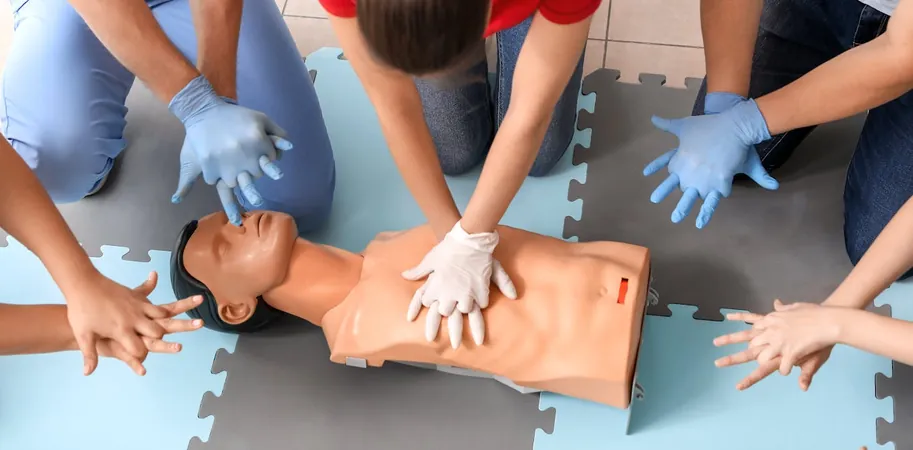
Women Facing Heart Attacks Are Less Likely to Get CPR—Could Changing Training Dummies Save Lives?
2024-11-22
Author: Wei Ling
In a life-or-death situation where someone's heart suddenly stops, immediate action is critical.
Cardiopulmonary resuscitation (CPR) can significantly boost survival chances by ensuring that blood continues to circulate, delivering oxygen to the brain and vital organs until professional medical assistance arrives.
Unfortunately, alarming research indicates that bystanders are less inclined to perform CPR on women compared to men. An examination of 4,491 cardiac arrest incidents in Australia between 2017 and 2019 revealed that while 74% of men received CPR, only 65% of women benefited from this lifesaving intervention.
The question arises: could the type of CPR training manikins we use contribute to this disparity? A study conducted by our team found that an overwhelming 95% of manikins used worldwide for CPR training are flat-chested, which raises concerns about how bystanders perceive cardiac emergencies involving women.
While the presence of breasts does not alter the technical aspects of performing CPR, it might affect the willingness of potential rescuers to intervene. The hesitation to act during these critical moments can determine whether a life is saved or lost.
An Unsettling Reality for Women's Heart Health
Heart-related ailments, including coronary artery disease and strokes, stand as the foremost cause of death for women globally. Strikingly, women have a 10% lower chance of receiving CPR in an out-of-hospital cardiac arrest scenario compared to men. This discrepancy leads to lower survival rates for women and an increased likelihood of neurological damage following a cardiac event.
The issue extends beyond women, affecting transgender and non-binary individuals as well. Studies reveal that their symptoms are often overlooked or misdiagnosed compared to men. Additionally, gender biases can result in delayed treatment, further exacerbating health inequalities.
The Reluctance to Act
Various studies show that bystander reluctance plays a significant role in the disparity of CPR application. Concerns about being accused of inappropriate behavior, fears of causing harm based on stereotypes of women being frail, and discomfort over touching a woman's breast are factors contributing to this hesitance.
Furthermore, it’s been documented that bystanders often fail to recognize when a woman is experiencing cardiac arrest. Simulations indicate they are less likely to undress a woman for proper resuscitation, reiterating the biases that permeate our emergency response systems.
The Male-Centric Approach to CPR Training
The data is concerning when it comes to the design of CPR training resources. Most manikins are predominantly white (88%), male (94%), and lean (99%), skewing the representation towards male bodies. For instance, a 2022 investigation into training manikins across the Americas highlighted that very few manikins reflect diversity in gender or body types.
Our own study identified only 20 CPR manikins available globally in 2023, and of those, merely five were classified as “female,” with only one featuring breasts. This glaring lack of representation poses critical questions about training paradigms and their effectiveness in real-life scenarios.
The Cultural Barriers to Life-Saving Actions
It’s vital to stress that the technique of CPR remains the same regardless of breast anatomy. The barriers preventing timely intervention lie predominantly in cultural perceptions and stereotypes. Overcoming discomfort in stressful situations is essential to saving lives.
Recognizing the signs of someone in need of CPR, such as unresponsiveness or irregular breathing, is crucial. Here’s a quick reminder of the correct technique to perform effective CPR:
1. Place the heel of your hand on the center of the chest.
2. Position your other hand on top of the first and interlock your fingers to maintain a straight posture with your arms.
3. Compress the chest at a depth of approximately 5 cm at a rate of 100-120 compressions per minute (you can use a familiar song to maintain the rhythm).
Addressing Defibrillator Use Concerns
While it’s unnecessary to remove a bra to perform CPR, if defibrillation is required, it may be essential to do so. Defibrillators can deliver an electric shock to restore the heart's rhythm, but underwire bras may cause mild burns during this process. Therefore, if removal isn't feasible, don’t let it hinder your response.
A Call for Change
Our findings underscore the urgent need for a variety of CPR training manikins that better reflect diversity, particularly with regard to body shapes and sizes. Enhancing the realism of CPR training is essential in ensuring that bystanders feel confident across all scenarios and are prepared to act, regardless of the victim's gender or appearance.
By addressing these disparities and revising training practices, we might bridge the gap in CPR applications and improve survival outcomes for everyone. Will the future of CPR training evolve to save more lives? The answer may depend on our commitment to inclusivity!

 Brasil (PT)
Brasil (PT)
 Canada (EN)
Canada (EN)
 Chile (ES)
Chile (ES)
 España (ES)
España (ES)
 France (FR)
France (FR)
 Hong Kong (EN)
Hong Kong (EN)
 Italia (IT)
Italia (IT)
 日本 (JA)
日本 (JA)
 Magyarország (HU)
Magyarország (HU)
 Norge (NO)
Norge (NO)
 Polska (PL)
Polska (PL)
 Schweiz (DE)
Schweiz (DE)
 Singapore (EN)
Singapore (EN)
 Sverige (SV)
Sverige (SV)
 Suomi (FI)
Suomi (FI)
 Türkiye (TR)
Türkiye (TR)